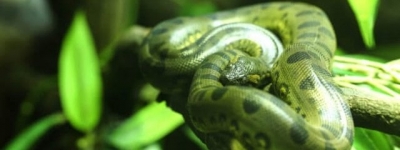
Anaconda, either of two species of constricting, water-loving snakes found in tropical South America. The green anaconda, also called the giant anaconda, sucuri, or water kamudi, is an olive-coloured snake with alternating oval-shaped black spots. The yellow, or southern, anaconda (E. notaeus) is much smaller and has pairs of overlapping spots.
Green anacondas lie in the water (generally at night) to ambush caimans and mammals such as capybara, deer, tapirs, and peccaries that come to drink. An anaconda seizes a large animal by the neck and almost instantly throws its coils around it, killing it by constriction. Anacondas kill smaller prey, such as small turtles and diving birds, with the mouth and sharp backward-pointing teeth alone. Kills made onshore are often dragged into the water, perhaps to avoid attracting jaguars and to ward off biting ants attracted to the carcass. In the wild, green anacondas are not particularly aggressive. In Venezuela, they are captured easily during the day by herpetologists who, in small groups, merely walk up to the snakes and carry them off.
Green anacondas mate in or very near the water. After nine months, a female gives live birth to 14–82 babies, each more than 62 cm (24 inches) in length. The young grow rapidly, attaining almost 3 metres (10 feet) by age three.
Credit : Britannica
Picture Credit : Google




